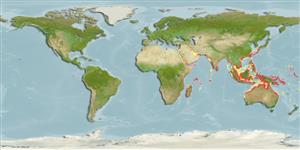Environment: milieu / climate zone / depth range / distribution range
Ecologie
marien; zoet water; brak water demersaal; amfidroom (Ref. 46888). Tropical
Indo-Pacific: Delagoa Bay, Mozambique and Madagascar to China and Philippines (Ref. 6802, 82489). Eastern Atlantic: collected from Port Harcourt (Niger delta in Nigeria) (Ref. 7391, 57413), apparently introduced (Ref. 7050). Also found (introduced) in Guinea and Cameroon (Ref. 82489). Other introduced populations are known from Panama, Venezuela and Brazil (Ref. 82489).
Grootte / Gewicht / Leeftijd
Maturity: Lm ? range ? - ? cm
Max length : 10.7 cm TL mannelijk / geslacht onbekend; (Ref. 57413)
Dorsale stekels (totaal): 7; Dorsale zachte stralen (totaal): 7-8; Anale stekels 1; Anale zachte stralen: 7 - 9. Diagnosis: 11-15 scales in predorsal series; 25-29 ctenoid scales in longitudinal series (including 1-2 scales on caudal fin base); 9-12 scales in rearward transverse series; 1st dorsal fin: VI; second dorsal fin: I,8 (rarely 7); anal fin: I,7-9 (usually 8); pectoral fins: 19-22; pelvics relatively long, their tips almost, or just reaching level of anus; caudal fin rounded, with 11-16 segmented rays (Ref. 57413, 82489). 1st gill arch with 4-5 gill rakers on epibranchial, 6-8 on ceratobranchial (Ref. 82489), about 12 in total, that are narrow and spine-like (Ref. 57413). Dark brown, scales edged in dark brown (Ref. 5493). Body with 4-5 oblique bands (Ref. 5493, 82489), crossing dorsum at nape, 1st dorsal fin, 2nd dorsal fin and caudal peduncle (one or two)(Ref. 82489). Anterior part of 1st dorsal fin dark, 2nd dorsal and caudal fin with alternating dark brown and white spots, anal and pelvic fins dusky to black, pectorals clear; females with more distinct bands and lighter fins (Ref. 5493).
Coloration: Preserved specimens: 2-3 longitudinal series of small dark spots above midline of flanks; broad, dark, crossbar running from each dorsal fin base towards belly, bifurcating on flanks into separate bands; 2 narrower crossbars on caudal peduncle; a lunate band on base of caudal fin; dark pre- and suborbital bands on head, confluent below eye; dark spot behind eye and light horizontal band running to posterior of operculum; snout marbled; 3 dark crossbars on nape preceding a light area in front of 1st dorsal-fin base; ventral area of head speckled; both dorsal fins with a dark proximal band; 1st dorsal fin more or less entirely dark to distal margin; 2nd dorsal fin with dark distal margin; anal and pelvic fins black, except distal area of pelvic fins lighter; pectoral fins with a dark spot at base (edged red in life) and an upper, smaller, dark spot sometimes evident (Ref. 57413).
Inhabits rivers, estuaries (Ref. 4967) and mangrove creeks (Ref. 10812). Feeds on crustaceans and small fishes. Marketed fresh (Ref. 12693). Maximum size recorded in West Africa was 8.3 cm TL (Ref. 57413).
Levenscyclus en paargedrag
Maturiteit | Voortplanting | Paaien | Eieren | Fecunditeit | Larven
Distinct pairing (Ref. 205).
Miller, P.J. and P. Wongrat, 1990. Eleotridae. p. 952-957. In J. C. Quéro, J. C. Hureau, C. Karrer, A. Post and L. Saldanha (eds.) Check-list of the fishes of the eastern tropical Atlantic (CLOFETA). JNICT, Lisbon; SEI, Paris; and UNESCO, Paris. Vol. 2. (Ref. 10812)
Status op de Rode Lijst van het IUCN (Ref. 130435)
Gevaar voor de mens
Harmless
Gebruik door de mens
Visserij:
Meer informatie
ReferentiesAquacultuurAquacultuurprofielKweeklijnenGeneticaElectrophoresesErfelijkheidZiektesVerwerkingNutrientsMassaconversie
Tools
Speciale rapporten
Download XML
Internetbronnen
Estimates based on models
Preferred temperature (Ref.
123201): 24.8 - 29.1, mean 28.3 °C (based on 1224 cells).
Fylogenetische diversiteitsindex (Ref.
82804): PD
50 = 0.5156 [Uniqueness, from 0.5 = low to 2.0 = high].
Bayesian length-weight: a=0.01230 (0.00622 - 0.02432), b=3.12 (2.94 - 3.30), in cm total length, based on LWR estimates for this species & (Sub)family-body (Ref.
93245).
Trofisch niveau (Ref.
69278): 4.0 ±0.66 se; based on food items.
Weerstandsvermogen (Ref.
120179): Hoog, minimale populatieverdubbelingstijd minder dan 15 maanden (Preliminary K or Fecundity.).
Fishing Vulnerability (Ref.
59153): Low vulnerability (10 of 100).
